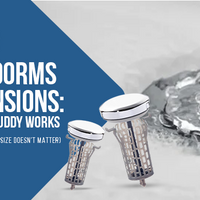You know the moment when you turn off the faucet, and the sink refuses to drain. That slow, gurgling sound usually means air is trapped by a partial clog — one of the most common signs your drain needs attention.
But before you reach for harsh chemical cleaners or make that expensive call to a plumber, take a deep breath! Most household clogs, especially those caused by hair, soap scum, or food debris, can be cleared quickly and safely using simple tools and everyday items.
This guide is your complete master plan. We’ll skip the plumbing jargon and walk you through five proven methods, starting with the easiest quick fixes and moving up to more advanced techniques.
1: The Boiling Water Method
Start simple. This quick, low-risk fix utilizes nothing more than heat and gravity to loosen greasy buildup or soap scum that clogs your drain.
Clear the area: Use a cup or bowl to remove any standing water so the hot water can hit the clog directly.
Boil the water: Bring a full kettle to a rolling boil.
Pour in stages: Slowly pour the boiling water down the drain in two to three rounds, pausing between each pour to let the heat do its work.
Test the flow: If the water drains faster but not fully, repeat once more.
Pro Tip: If your plumbing uses PVC or plastic pipes, swap boiling water for very hot tap water. Extreme heat can cause joints to warp or loosen. This method also helps prep the drain before trying stronger unclogging techniques.
2: The Baking Soda & Vinegar Reaction
When baking soda and vinegar meet, they create a fizzing reaction that helps loosen soft buildup, clear mild clogs, and neutralize odors. It’s eco-friendly, inexpensive, and safe for all pipe types.
Add the base: Pour ½ cup of baking soda directly into the drain.
Add the acid: Follow with 1 cup of white vinegar.
Trap the reaction: Quickly seal the drain with a stopper or a wet rag to contain the fizzing pressure within the pipe. Let it bubble for 15–30 minutes.
Flush it clean: Remove the plug and pour a full pot of hot water to wash away loosened debris and residue.
Pro Tip: For deeper deodorizing and better breakdown of stubborn gunk, leave the mixture overnight before flushing. It’s one of the safest ways to refresh slow drains without harsh chemicals.
Method 3: The Plunger
When a clog appears out of nowhere, such as after washing dishes or rinsing food, the suction power is often your quickest fix. A plunger can dislodge blockages caused by food scraps, grease buildup, or trapped air pockets without the need for chemicals.
Prep the seal: Fill the sink with enough water to cover the plunger cup. Water helps create strong suction pressure.
Seal the overflow: For sinks with an overflow opening, tightly block it with a wet rag to concentrate suction power on the clog.
Plunge effectively: Use a flat-bottomed sink plunger (not the bell-shaped toilet kind). Place it firmly over the drain and pump up and down 10–15 times with steady force.
Break the seal: Pull up sharply and check if the water drains. Repeat a few cycles if needed.
Pro Tip: If the clog clears but drains slowly, finish with a round of hot water to flush away leftover debris. Keeping a dedicated flat plunger for your sink prevents cross-contamination and keeps future cleanups safe and easy.
Method 4: The Drain Snake
When boiling water and plunging don’t cut it, the drain snake (also called a plumber’s auger) is your go-to for deep or stubborn clogs. It’s especially useful for removing tangled hair, grease buildup, or debris lodged far down the pipe.
Insert carefully: Feed the tip of the snake into the drain opening. Turn the handle while gently pushing it deeper until you feel firm resistance — that’s the clog.
Break or grab the blockage: Rotate the handle to either break the clog apart or hook it so you can pull it out.
Retract and clean: Slowly pull the snake back up, wiping off any debris as you go.
Flush it clean: Finish by running a pot of hot water down the drain to wash away any leftover residue.
Pro Tip: If you don’t have a manual drain snake, a disposable plastic hair remover tool works well for bathroom sinks or showers. It’s an inexpensive alternative that keeps clogs under control before they get deep enough to need a full auger.
Method 5: Cleaning the P-Trap
If you’ve tried everything else and the clog still won’t budge, the blockage is probably hiding in the P-trap, the curved pipe under your sink that often collects grease, hair, and small objects (like rings or bottle caps).
Prep your workspace: Place a bucket or large bowl directly under the P-trap to catch any water or debris.
Loosen the fittings: Use channel-lock pliers to gently unscrew the slip nuts on both ends of the trap.
Remove and clean: Carefully slide the trap off and empty its contents into the bucket. Use a brush or bottle cleaner to scrub away buildup.
Reassemble securely: Reattach the trap and tighten the nuts hand-tight, then give them a gentle extra quarter-turn with pliers — avoid overtightening to prevent cracking.
Test for leaks: Run water through the drain and inspect all joints to make sure everything is watertight.
Pro Tip: Before reattaching, rinse the trap with a mix of hot water and baking soda to neutralize odor-causing bacteria and prevent future buildup.
When to Call a Professional
These five DIY methods can clear most household clogs, but knowing when to stop can save you from costly plumbing or water damage.
Call a plumber if:
None of the above methods clear the clog.
Multiple fixtures (like the toilet and shower) are backing up at once — this signals a deeper main sewer line issue.
You notice leaks from the pipes after attempting any fix.
You’re uncomfortable handling tools like a drain snake or opening the P-trap.
Chances are, if you hear persistent gurgling after multiple drains run, it may indicate a venting or mainline blockage, not just a simple clog.
Prevention Tips
An ounce of prevention is worth a lot of saved plumbing bills and less mess.
Use drain strainers or hair catchers like Drain Buddy in every sink, shower, and tub.
Ensure proper disposal. Trash cans are for waste; drains are for water. Never pour fats, oils, or grease down the drain.
Follow toilet rules. Only flush toilet paper — never wipes, floss, or cotton swabs.
Flush drains weekly with hot water, and do a monthly baking soda and vinegar cleanse to keep pipes clear and odor-free.
FAQs About Drain Cleaning
Should I use liquid chemical drain cleaners?
Avoid chemical drain cleaners whenever possible. They’re highly corrosive, can weaken PVC or metal pipes, and may release harmful fumes or splash back during use. Try natural options like baking soda and vinegar, or mechanical methods like a plunger or drain snake.
Can I use a wire coat hanger to snake a drain?
Yes, but only for minor clogs near the surface. Straighten the wire coat hanger and bend a small hook at one end to pull out hair or debris from a sink or shower drain. Be gentle and avoid scratching the inside of your pipes. For deeper or tougher blockages, use a proper drain snake.
How often should I clean my P-trap?
If you regularly use a strainer, you’ll rarely need to clean your P-trap. Do so only when you suspect a clog, notice slow drainage, or accidentally drop something valuable down the drain. Cleaning it occasionally helps maintain smooth water flow and prevent foul odors.
Conclusion
By starting with these simple, safe methods, you can clear most household clogs on your own.
Adopt these habits today—install a Drain Buddy to catch hair, and combine it with easy fixes like plunging, snaking, and cleaning the P-trap—to enjoy free-flowing drains and take control of your home’s plumbing. Trust us, you’ll be glad you did!






